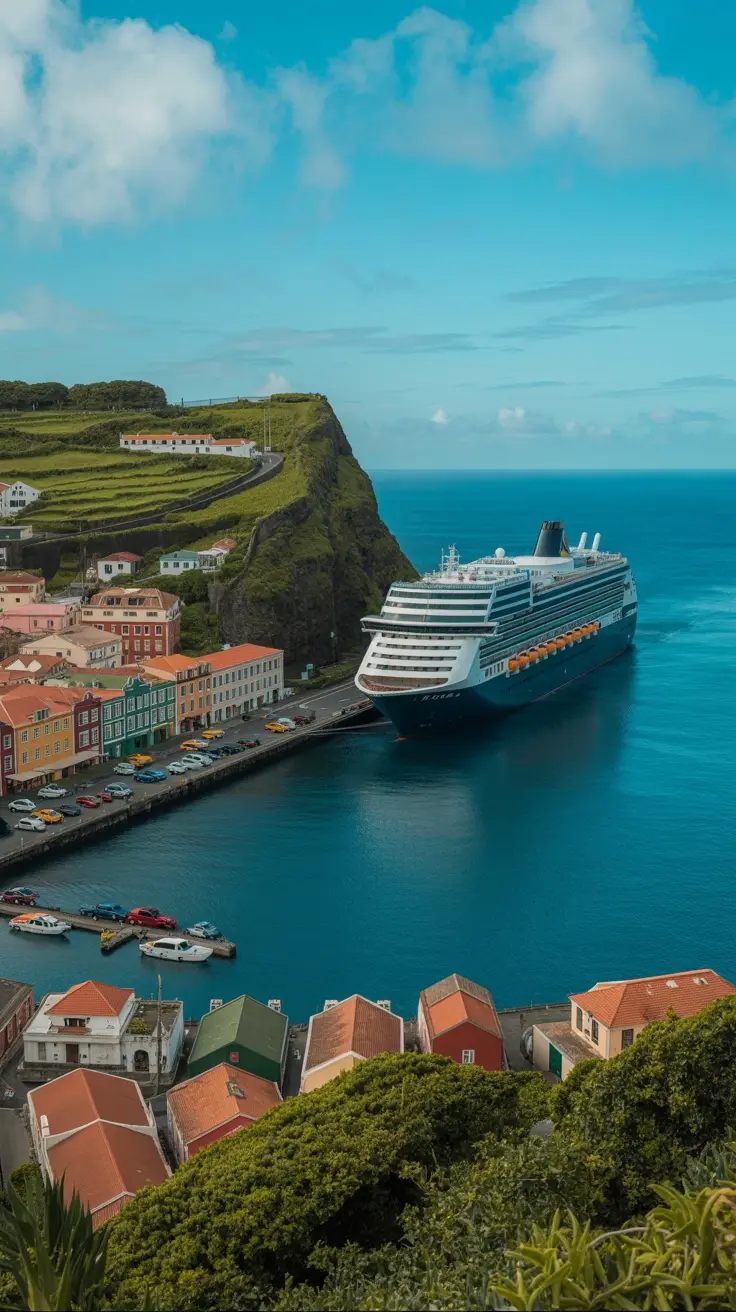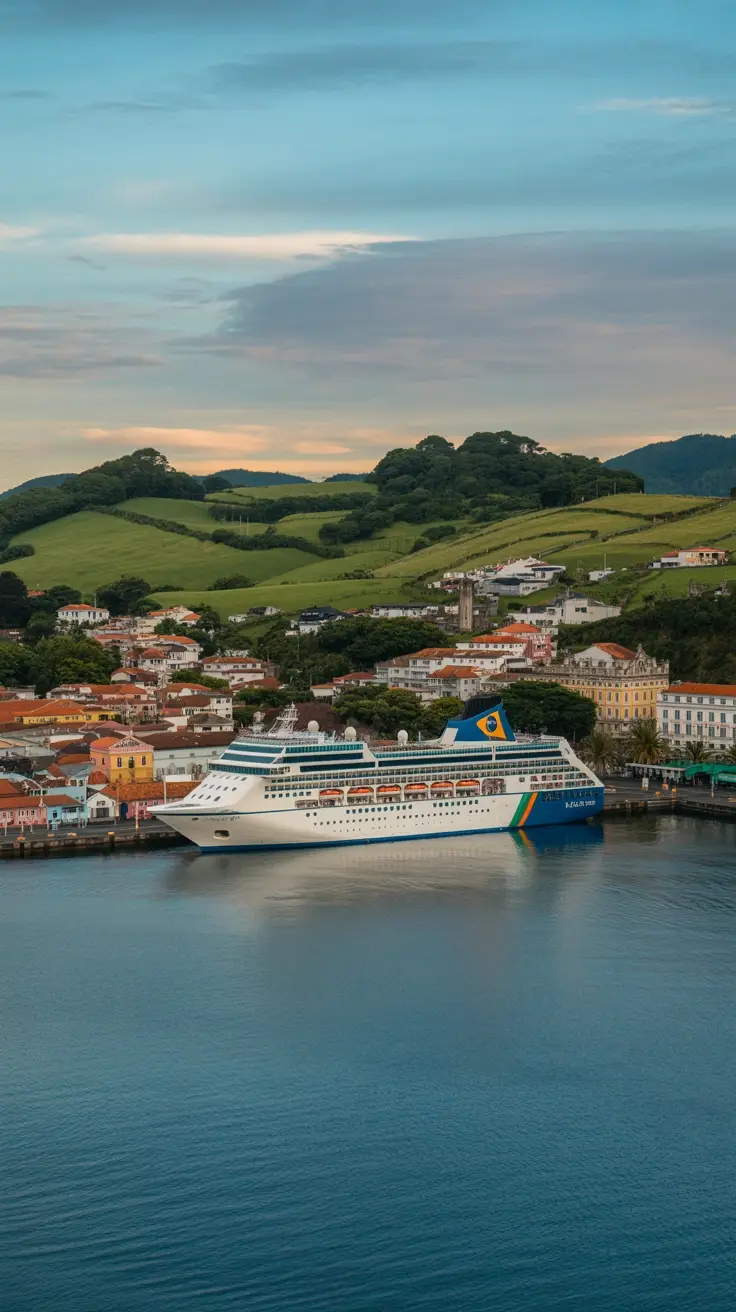Atlantic crossings bring their own rhythm, and the Azores serve as a natural stopping point that demands careful planning.
After countless voyages through these Portuguese islands, I’ve learned that each of the six main cruise ports has its own personality and logistics that can shape your entire visit.
First-time visitors often underestimate how different these ports are from typical Caribbean or Mediterranean stops.
The weather changes quickly, port facilities vary dramatically between islands, and shore excursion options depend heavily on which island you’re visiting. Some ports handle large ships easily while others require tender operations that eat into your precious shore time.
The real challenge comes in matching ports to your interests.
São Miguel’s Ponta Delgada works well for those wanting volcanic landscapes and tea plantations, while Terceira’s Praia da Vitória suits history enthusiasts.
Faial attracts sailors and whale watching fans, and the smaller ports like Flores reward those seeking dramatic coastlines and waterfalls.
Understanding these distinctions before you book makes all the difference between a memorable stop and a missed opportunity.
Ponta Delgada – São Miguel Island Cruise Ship Port Guide

When your cruise ship approaches Ponta Delgada, you’ll dock at Terminal Maritimo (Portas do Mar), which features a 380-meter berth just 200 meters from São Miguel Island’s historic downtown. You won’t need shuttles since you’ll dock directly alongside the terminal. The port’s 11-meter depth accommodates vessels perfectly, while on-site restaurants, shops, and tourist services welcome you immediately upon arrival. If multiple ships visit simultaneously, some dock at the scenic breakwater pier extending 0.85 miles parallel to the city. This strategic location puts you within walking distance of Ponta Delgada’s charming historic center and local attractions.
Praia da Vitória – Terceira Island Cruise Ship Port Guide
Your cruise ship will dock at Praia da Vitória‘s sheltered natural harbor on Terceira Island’s eastern coast, where the port accommodates vessels up to 300 meters in length with drafts reaching 10.5 meters. The port requires compulsory pilotage services and provides mooring assistance via VHF Channel 16, along with essential amenities like freshwater supply and waste collection. The terminal sits just 3 km from Praia da Vitória’s city center and 7 km from Lajes Airport. From here, you can visit the 16th-century Forte de São João Baptista, spend time on Terceira’s largest sand beach, or make your way to UNESCO-listed Angra do Heroísmo, located 20 km away.
Horta – Faial Island Cruise Ship Port Guide

Situated on Faial Island’s southeast coast, Horta’s cruise port stands as one of the Azores’ most accessible and well-equipped harbors for visiting vessels. Ships dock just 500 meters from downtown, where sailors and passengers have been gathering at the legendary Peter Café Sport for generations. The main terminal handles ships up to 230 meters and provides full services including pilotage, water, and waste disposal. The marina community includes more than 300 berths with extensive repair facilities that have served transatlantic voyagers for decades. Whale watching tours depart regularly from the harbor, while the fascinating Scrimshaw Museum showcases maritime art just steps from the waterfront. Capelinhos Volcano, site of the archipelago’s most recent eruption, makes for a compelling day trip. The harbor master maintains watch on VHF channels 9 and 16 for maritime safety communications.
Vila do Porto – Santa Maria Island Cruise Ship Port Guide
Vila do Porto’s cruise port might not match the scale of larger Azorean harbors, but its location makes up for what it lacks in facilities. Ships dock just 2 km from the town center and 3 km from Santa Maria Airport, making transfers straightforward and quick. The port has two piers that can handle vessels up to 120 meters, with basic services including fresh water supply and waste disposal available.
The walk to town involves a steep uphill climb, but hourly buses and taxis provide reliable connections to Vila do Porto’s historic center, beaches, and volcanic landscapes. Ships must use pilotage services when entering the port, with initial contact made through VHF Channel 16. While the port facilities are modest, they’re perfectly adequate for the island’s cruise traffic, and the proximity to town means you won’t waste time on long transfers.
Angra do Heroísmo – Terceira Island Cruise Ship Port Guide

Moving from Santa Maria’s modest port facilities to Terceira Island, Angra do Heroísmo’s cruise port features a more developed harbor just 600 meters from the UNESCO World Heritage city center. Dedicated facilities serve smaller cruise ships, while larger vessels use the tender pier. The port accommodates ships up to 100m with an 84m berthing line and 6.5m maximum draft. Essential services include freshwater supply, fuel, waste disposal, and a 50-ton crane. With taxis, restaurants, and historic sites within walking distance, you’re perfectly positioned to explore this captivating Azorean destination.
Santa Cruz das Flores Cruise Ship Port Guide
Santa Cruz das Flores serves as the primary cruise port on Flores Island’s western coast, functioning as both a commercial harbor and the main gateway for cruise ships visiting this remote Azorean destination. The port also maintains regular ferry connections to neighboring Corvo Island, making it a vital transportation hub for the archipelago’s westernmost islands.
The harbor is currently in the midst of significant reconstruction work aimed at modernizing its facilities and improving passenger amenities. Multiple terminals within the port complex can handle vessels of varying sizes, though the infrastructure remains primarily commercial in nature. Private yachts should note that the facility isn’t particularly suited for their needs and may want to consider alternative mooring options.
As the island’s main maritime gateway, the port area has naturally developed into a center for essential services. The surrounding neighborhood contains Flores’ principal health facilities, educational institutions, and commercial establishments. This concentration of infrastructure makes practical sense given the port’s role as the island’s primary connection point to the outside world.
The ongoing development projects focus on upgrading passenger facilities while preserving the port’s crucial role in maintaining ferry services. These improvements are particularly important given the isolated location of both Flores and Corvo in the Atlantic, where reliable maritime connections remain essential for both residents and visitors alike.
Frequently Asked Questions
What Is the Best Time of Year to Cruise to the Azores?
The sweet spot for cruising to the Azores runs from May through October. During these months, you’ll find stable weather patterns, calmer seas, and favorable trade winds that make for smooth sailing. Most experienced cruisers prefer this window since the Atlantic behaves itself better, and you’re less likely to encounter rough conditions that can turn a dream vacation into a rocky nightmare.
Do I Need a Visa to Visit the Azores on a Cruise?
You probably won’t need a visa if you’re from the EU, US, Canada, Australia, or UK and staying less than 90 days. The Azores are part of Portugal, so standard Schengen rules apply. Your cruise line handles most of the paperwork for you – they’ll submit passenger manifests to port authorities before arrival. Just make sure your passport is valid for at least six months past your travel date. If you’re from another country, check Portugal’s visa requirements, though cruise passengers often get more lenient treatment than regular tourists.
What Currency Is Used in the Azores and Are Credit Cards Accepted?
Since the Azores are part of Portugal, you’ll need Euros for all your purchases. Most restaurants, hotels, and shops in the main towns accept Visa and Mastercard without any issues. That said, smaller family-run businesses, local markets, and establishments in remote villages often operate on a cash-only basis. ATMs are readily available in larger towns like Ponta Delgada and Horta, so withdrawing cash when you arrive is straightforward. Just remember to notify your bank about your travel dates to avoid any card blocks while you’re island hopping.
How Many Days Should I Plan for an Azores Cruise Itinerary?
You’ll need 7-10 days for a meaningful Azores cruise. This timeframe allows you to visit 3-4 islands, go whale watching, hike volcanic trails, and genuinely connect with the islands’ distinctive culture and landscapes. Anything shorter and you’ll feel rushed; anything longer might be too much unless you’re passionate about volcanic islands or marine life.
What Vaccinations or Health Precautions Are Required for Azores Travel?
No mandatory vaccinations are required for the Azores unless you’re coming from yellow fever areas. That said, it’s smart to have your hepatitis A, typhoid, and routine vaccines up to date before traveling.
Make sure to pack any prescription medications in their original containers with proper documentation. Travel insurance is always a good idea – medical facilities in the Azores are generally good, but you’ll want coverage just in case.
While mosquito-borne illnesses aren’t a major concern in the Azores, bringing insect repellent is still wise, especially if you plan to spend time hiking or in rural areas during warmer months.
